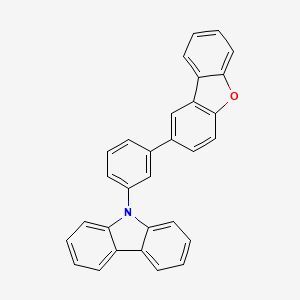CzDBF
Properties
| Signal Word | Warning |
Product Description
CzDBF, scientifically known as 9-(3-(dibenzo[b,d]furan-2-yl)phenyl)-9H-carbazole, is a specialized organic compound engineered for applications in optoelectronics and material science. Its structure combines dibenzo[b,d]furan and carbazole units, providing enhanced properties such as high thermal stability, efficient hole transport capabilities, and strong luminescence. These attributes make CzDBF particularly effective in the development of advanced electronic devices, including those requiring efficient charge transport mechanisms and stable light-emitting properties.
Application
CzDBF is primarily employed in the production of Organic Light Emitting Diodes (OLEDs), where it contributes to improved device efficiency and operational lifetime. Its superior hole transport properties enhance the overall brightness and energy efficiency of OLED displays. Additionally, CzDBF plays a crucial role in the formulation of organic semiconductors, contributing to the performance of various optoelectronic technologies through its ability to facilitate charge transport. Furthermore, its luminescent properties make it suitable for applications in sensors and photonic devices, offering potential for high sensitivity and selectivity in detection systems.
Articles:
- Synthesis and device application of hybrid host materials of carbazole and benzofuran for high efficiency solution processed blue phosphorescent organic light-emitting diodes
Publication Date: Available online 7 February 2013
Chil Won Lee, Kyoung Soo Yook, Jun Yeob Lee
https://doi.org/10.1016/j.orgel.2013.01.025
-Small Molecule Host Materials for Solution Processed Phosphorescent Organic Light-Emitting Diodes
Publication Date: 07 May 2014
Kyoung Soo Yook, Jun Yeob Lee
https://doi.org/10.1002/adma.201306266
- Solution processed phosphorescent white organic light emitting diodes using a small molecule host material
Publication Date: Available online 11 June 2013
Kyoung Soo Yook, Jun Yeob Lee
